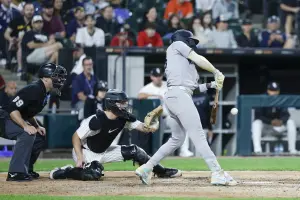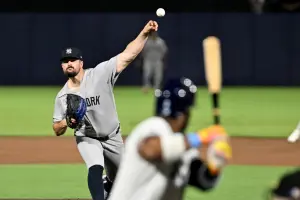
(*) F/F SPOTLIGHT: Drew Pomeranz
[Ed. note—We kick off our first week of incorporating 2016 stats into all our Fact/Fluke pieces with the return of Fact/Fluke Spotlight, where we take a deep dive into one specific player. This is our third season of this column, which expands our classic Fact/Fluke model to include additional evaluation tools such as heat maps, spray charts, pitch selection data, and more. Fact/Fluke Spotlight will run every Monday though mid-August.]
There is a psychological tendency that causes many of us to jump on the next hot prospect, especially in keeper leagues. There is great satisfaction in being the first in your league to recognize the upside of a player before it materializes.
A reverse tendency exists too. Once that prospect burns us because he flops or gets injured, many of us swear never to roster him again. We don’t want to get burned twice.
However, player development often isn’t linear; it takes a windy path. The key is to know when to jump back on the bandwagon after you’ve abandoned hope.
Take lefty Drew Pomeranz (LHP, SD) for example. He’s a former top prospect who is starting to show significant growth, albeit in a tiny early sample size.
Among starting pitchers with at least 20 IP so far this season, just two of them own both a 45%+ GB% and a 15% SwK%. One is turning into the game’s most dominant SP: Noah Syndergaard (RHP, NYM). The other? Pomeranz.
Take charge of your league in 2016 with a BaseballHQ.com subscription that unlocks articles like these all offseason long. Winning. Fantasy baseball. Insight.
Background
Pomeranz was drafted by the Cleveland Indians with the fifth overall pick of the 2010 amateur draft out of the University of Mississippi. He was drafted eight spots ahead of another one of today’s most dominant SP: fellow lefty Chris Sale (LHP, CHW).
Pomeranz was profiled as someone with the potential to be a number one or two starter as a result of the heavy movement on his low-90s fastball and strong knuckle-curve.
Minor League History
As a college pitcher, it was expected that Pomeranz would move quickly through the minors. Turns out he flew through the minors early in his career and paid for it later.
He started his professional career in 2011 at High-A Kinston in the CLE organization.
Pomeranz featured a lot of strikeouts and groundballs in the minors:
Year Age Level IP ERA WHIP Ctl Dom HR/9 G/F ==== === ======== === ==== ==== ==== ==== ==== ==== 2011 22 High-A 77 1.87 1.14 3.7 11.1 0.2 1.11 2011 22 Double-A 14 2.57 1.14 3.9 10.9 0.6 0.41 2011 22 Double-A 10 0.00 0.20 0.0 6.3 0.0 0.28 2012 23 Double-A 4 0.00 1.25 2.3 9.0 0.0 2.00 2012 23 Triple-A 46 2.51 1.54 3.9 9.0 0.4 1.54 2013 24 Triple-A 85 4.20 1.35 3.5 10.2 0.6 1.29 2013 24 Double-A 5 11.81 2.06 1.7 8.4 3.5 1.20 2014 25 Triple-A 46 3.69 1.34 3.3 9.1 1.2 0.95 2015 26 High-A 2 0.00 0.00 0.0 13.5 0.0 2.00
In addition to being rushed to the majors, he was never allowed to throw more than 100 IP at any professional stop.
After being traded to the Rockies in mid-2011 as part of the Ubaldo Jiménez deal, Pomeranz made it all the way to the majors during his first professional season. He was ranked by Baseball America as the game’s #30 prospect after the 2011 season.
MLB History
Pomeranz made his MLB debut with COL during his first professional season in 2011. His first extended look came the following season.
Year IP ERA WHIP Ctl Dom HR/9 GB% SwK% FpK% BPV ==== == ==== ==== === ==== ==== === ==== ==== === 2011 18 5.40 1.31 2.5 6.4 0.0 47% 5% 57% 74 2012 97 4.93 1.48 4.3 7.7 1.3 44% 10% 56% 45 2013 22 6.23 2.03 7.9 7.9 1.7 51% 8% 54% -42 2014 69 2.35 1.12 3.4 8.3 0.9 46% 9% 52% 83 2015 86 3.66 1.19 3.2 8.6 0.8 42% 12% 58% 87
His early MLB career was plagued with control issues and difficulties missing bats, which kept his strikeouts lower than his scouting reports suggested they could be.
Pomeranz was on the move again after the 2013 season when the Rockies traded him to the A’s for fellow lefty Brett Anderson.
In 2014, Pomeranz’s stats and skills started to reflect his upside. But he shuttled between relief and starting roles that season, and he showed some maturity issues by breaking his hand after punching a wall.
While his stats that season were better in relief, his skills were decidedly better out of the rotation:
2014 IP ERA WHIP Ctl Dom HR/9 GB% BPV ===== == ==== ==== === ==== ==== === === As SP 52 2.58 1.13 3.4 8.6 0.9 46% 87 As RP 16 1.62 1.08 3.2 7.6 1.1 43% 71
Pomeranz was primed to stick as a starter during the 2015 season after winning a job out of the spring, but he went to the DL early in the season and was moved to the bullpen when he returned. He flashed some electric skills in relief and even got some save opportunities.
Pomeranz pitched nearly an equal number of innings in 2015 as both a SP and RP. His stats and skills were better out of the bullpen:
2015 IP ERA WHIP Ctl Dom HR/9 GB% BPV ===== == ==== ==== === ==== ==== === === As SP 44 4.63 1.30 3.4 7.3 1.0 38% 56 As RP 41 2.61 1.06 3.1 10.0 0.7 48% 122
It should not come as a surprise that the lefty Pomeranz was especially electric against LH batters:
2015 IP WHIP Ctl Dom HR/9 GB% BPV ====== == ==== === ==== ==== === === vs. LH 29 0.74 2.1 10.0 0.6 44% 145 vs. RH 56 1.42 3.8 7.8 1.0 42% 58
After the 2015 season, Oakland traded Pomeranz to the Padres.
Control Issues
Many of Pomeranz’s struggles throughout his professional career can be traced back to control problems.
Our research on first-pitch strikes and ball percentages suggest that they are linked closely with a pitcher’s control—especially ball%.
Average values for these metrics are a ball% of 36% and a FpK% of 60%. Pomeranz has consistently underperformed in these measures over his MLB career:
Season Ball% FpK% ====== ===== ==== 2011 38% 57% 2012 39% 56% 2013 40% 54% 2014 38% 52% 2015 38% 58%
PITCHf/x Analysis
Pomeranz was drafted as a pitcher with two strikeout pitches: a moving low-90s fastball and knuckle-curve.
A glance at his PITCHf/x over the last two seasons confirms that he relies significantly on both of those pitches:
PITCHf/x Year Usage Velocity SwK% Ball% ================== ==== ===== ======== ===== ===== Four-Seam Fastball 2014 49% 91.7 8.1% 32% Knuckle-Curve 2014 27% 80.7 12.0% 38% Two-Seam Fastball 2014 23% 89.4 5.0% 45% Curveball 2014 3% 80.3 8.3% 53% Changeup 2014 1% 84.5 11.1% 56% ------------------------------------------------------- Four-Seam Fastball 2015 58% 91.9 14.1% 30% Knuckle-Curve 2015 30% 79.9 8.2% 46% Two-Seam Fastball 2015 9% 88.3 4.4% 43% Changeup 2015 4% 83.6 0.0% 50%
Pomeranz controls his four-seam fastball very well—note the low ball% on that pitch. He also was able to generate a lot of swings-and-misses with it in 2015.
Conversely, he has struggled to throw his other pitches for strikes. See the high ball% on his knuckle-curve and two-seam fastball.
Through last season, Pomeranz was unable to find a third strikeout pitch to pair with his four-seam fastball and knuckle-curve.
Prior to this season, he consistently used his four-seam fastball as a put-away pitch with two strikes on batters (data courtesy of BrooksBaseball.net):
Batters tend to hit for average against Pomeranz’s two-seam fastball (sinker) and for power against his four-seam fastball (data courtesy of BrooksBaseball.net):
Typically they hit for neither average or power against his curveball, but he hasn’t shown the confidence or pitch sequencing aptitude to go to that pitch late in counts against RH bats. At least not until this season.
2016 Results
Pomeranz entered the 2016 season again with an unknown role. He also carried into the year the profile of a pitcher who struggled to throw strikes and had not found a third strikeout pitch to complement his four-seam fastball and curveball.
Let’s insert Pomeranz’s very early 2016 results over his first four starts into his MLB stats and skills line:
Year IP ERA WHIP Ctl Dom HR/9 GB% SwK% FpK% Ball% BPV ==== == ==== ==== === ==== ==== === ==== ==== ===== === 2011 18 5.40 1.31 2.5 6.4 0.0 47% 5% 57% 38% 74 2012 97 4.93 1.48 4.3 7.7 1.3 44% 10% 56% 39% 45 2013 22 6.23 2.03 7.9 7.9 1.7 51% 8% 54% 40% -42 2014 69 2.35 1.12 3.4 8.3 0.9 46% 9% 52% 38% 83 2015 86 3.66 1.19 3.2 8.6 0.8 42% 12% 58% 38% 87 2016 22 2.86 1.32 4.9 12.7 0.8 45% 16% 56% 38% 119
Pomeranz’s strikeouts are soaring; see his elite 12.7 Dom and 16% SwK%.
The key to his dominance has been a greater utilization of his knuckle-curveball, a pitch that he has refined further to become a wipeout pitch. He is now throwing it more than even his four-seam fastball, and with the best results of his MLB career:
PITCHf/x Year Usage Velocity SwK% Ball% ================== ==== ===== ======== ===== ===== Four-Seam Fastball 2014 49% 91.7 8.1% 32% Knuckle-Curve 2014 27% 80.7 12.0% 38% Two-Seam Fastball 2014 23% 89.4 5.0% 45% Curveball 2014 3% 80.3 8.3% 53% Changeup 2014 1% 84.5 11.1% 56% ------------------------------------------------------- Four-Seam Fastball 2015 58% 91.9 14.1% 30% Knuckle-Curve 2015 30% 79.9 8.2% 46% Two-Seam Fastball 2015 9% 88.3 4.4% 43% Changeup 2015 4% 83.6 0.0% 59% ------------------------------------------------------- Knuckle-Curve 2016 42% 79.8 20.7% 44% Four-Seam Fastball 2016 37% 91.2 12.2% 29% Two-Seam Fastball 2016 8% 87.6 9.1% 43% Changeup 2016 2% 85.0 16.7% 50%
We know that Pomeranz typically has used his four-seam fastball as a put-away pitch. He has shifted that approach this year and is using his knuckle-curve in the vast majority of times he has two strikes on RH batters (data courtesy of BrooksBaseball.net):
One reason for caution is that Pomeranz isn’t throwing his knuckle-curve for strikes; see his 44% ball% with it. He has made up for it because he is inducing batters to swing at it more, and when they do, they are struggling a lot more to make contact against it than they did in 2015:
Knuckle-Curve PITCHf/x Season Swing% Contact % ====== ====== ========= 2015 35% 77% 2016 40% 49%
Pomeranz’s recent PQS-5 start against a strong PIT lineup shows how he was able to combine throwing his four-seam fastball up in the zone with his excellent knuckle-curve low in the zone to keep the eye level of batters moving, as well as his refined approach to use his curveball as a put-away pitch:
In addition, Pomeranz is showing some very early signs that his changeup could be developing into a third pitch that he can use to keep RH bats honest.
He has thrown the pitch 40 times so far in 2016. Hitters have managed only one extra-base hit against it (data courtesy of BrooksBaseball.net):
Pomeranz is only throwing his changeup against RH bats, and only as the first pitch of an at-bat or when he is ahead (data courtesy of BrooksBaseball.net):
If his early success with it sticks, expect him to expand usage of it. Given that he still is not throwing his knuckle-curve in the strike zone at a high rate, once batters start laying off it, he will need another off-speed pitch to complement his fastball.
Conclusions
At age 27, Pomeranz is still young enough to take a sustained big step forward. He was recalled to the majors early in his career without enough seasoning in the minors, and he’s now on his fourth MLB team in five seasons—largely due to no fault of his own. His development also has been stalled due to inconsistent utilization. He has routinely bounced between starting and relieving roles, which has hampered his ability to develop as a SP.
His refined curveball now has become one of the better curveballs in MLB, and he’s showing increased confidence in using it as a punchout pitch. Problem is, Pomeranz is not throwing it in the strike zone at a high rate, which means he will need to adjust once batters start laying off it.
He still needs a third pitch to sustain his early breakout signs. Very early indications suggest that his changeup could become that pitch, but it is too early to know for sure.
In addition to a third strikeout pitch, Pomeranz will need to lower his overall ball percentage in order to avoid the control lapses that have plagued him in the past.
While these concerns may keep owners away, he likely will not be available in many leagues if he continues to show the flashes that he has displayed early in the season. As such, he makes for a strong early speculative target, especially in keeper leagues and those that count strikeouts.








